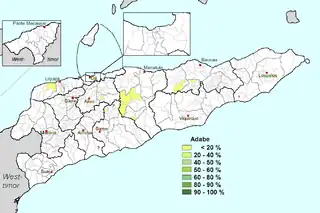Wetarese language
Wetarese is an Austronesian language of Wetar, an island in the south Maluku, Indonesia, and of the nearby islands Liran and Atauro, the latter island separate from the mainland of East Timor, north of Dili.[2]
| Wetarese | |
|---|---|
| Wetar | |
| Tutunohan | |
| Native to | East Timor, Indonesia |
| Region | Wetar Island, Atauro Island, Laclo |
Native speakers | (11,000 cited 1990–2010)[1] |
Austronesian
| |
| Official status | |
Recognised minority language in | |
| Language codes | |
| ISO 639-3 | Variously:apx – Aputaiilu – Iliʼuunwet – Paraitzn – Tugunadb – Atauran |
| Glottolog | weta1245 |
| ELP | Aputai |
 | |
Background
The four identified principal varieties of Wetarese on Wetar – Aputai, Iliʼuun, Parai and Tugun – are distinct enough that some may consider them to be different languages. Half of Wetarese speakers live on the island of Atauro in East Timor, where three closely related dialects (presumably of Iliʼuun) are spoken: Rahesuk (Rasua) in the center, Resuk (Hresuk) in the southeast, and Adabe (Raklungu) in the southwest.[2] Daduʼa in the extreme north is a subdialect of Rahesuk, and has been reported to be intelligible with the Iliʼuun of Liran Island. About half the Daduʼa population has moved to Timor, on the coast of Manatuto district, where it has undergone influence from Galoli.[3]
Wetarese is closely related to Galoli, spoken on the north coast of East Timor and by an immigrant community on the south coast of Wetar.
Adabe "language"
The Raklungu dialect of Atauro, or Kluʼun Hahan Adabe, was mistaken for a Papuan language by Antonio de Almeida (1966) and reported as "Adabe" in Wurm & Hattori (1981). Many subsequent sources propagated this error, showing a Papuan language on Atauro Island.[4] Geoffrey Hull, director of research for the Instituto Nacional de Linguística in East Timor, describes only Wetarese being spoken on Ataúro Island, and was unable to find any evidence of a non-Austronesian language there.[2]
Phonology
The following represents the Tugun dialect:[5]
Consonants
| Labial | Alveolar | Palatal | Velar | Glottal | ||
|---|---|---|---|---|---|---|
| Plosive | voiceless | p | t | tʃ | k | ʔ |
| voiced | dʒ | ɡ | ||||
| Fricative | voiceless | f | s | h | ||
| voiced | v | |||||
| Nasal | m | n | ŋ | |||
| Tap/Trill | ɾ ~ r | |||||
| Lateral | l | |||||
- /v/ may also be heard as [w] in free variation.[5]
- /r/ is mainly heard as [r] in word-final position or in slower speech, it is heard as [ɾ] elsewhere.[5]
- /ʔ/ only occurs in word-medial positions.[5]
Citations
- Aputai at Ethnologue (18th ed., 2015) (subscription required)
Iliʼuun at Ethnologue (18th ed., 2015) (subscription required)
Parai at Ethnologue (18th ed., 2015) (subscription required)
Tugun at Ethnologue (18th ed., 2015) (subscription required)
Atauran at Ethnologue (18th ed., 2015) (subscription required) - Hull, Geoffrey (2002), The Languages of East Timor: Some Basic Facts (PDF), Instituto Nacional de Linguística, Universidade Nacional de Timor Lorosa'e
- "Numeral Systems of the World's Languages > Dadu'a". mpi-lingweb.shh.mpg.de. Retrieved 2019-11-26.
- Ethnologue (2013), for example, shows "Adabe" being spoken on central Atauro, in the area of Raklungu, and lists the population of all three dialects of Atauro Wetarese as being Papuan Adabe.
- Hinton (2000), p. 115
References
- Hinton, Bryan D. (2000). "The languages of Wetar: recent survey results and word lists with notes on Tugun grammar". In Grimes, Charles E. (ed.). Spices from the East: Papers in Languages of Eastern Indonesia. Canberra: Pacific Linguistics. pp. 105–129. doi:10.15144/PL-503.105. hdl:1885/146101.